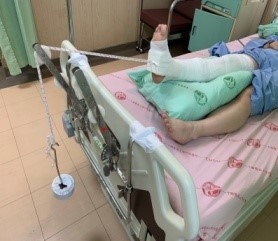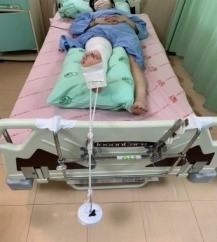The goal of traction
- Stabilize bone fracture.
- Maintain proper body alignment.
- Reduce bone fracture.
- Alleviate muscle spasm.
- Rectify and prevent deformity.
- Release muscular tissue adhesion.
Type of traction
- Skin traction: adhere and fix the traction belt exerting tension on the skin on both sides of the affected limb to promote fracture reduction and reduce pain in the affected limb.


- Bone traction: Fix the steel nail at the distal end of the fracture to traction the bone, promote fracture reduction and reduce pain in the affected limb.

Cautions
- Tighten all traction ropes located at the wheel of the ditch pulleys,
- Keep the traction rope and the pulley on the traction frame in a straight line with the long bone, knee joint and second toe of the affected limb.
- Do not place anything on the rope or have it twisted with knots.
- The weight should be vertically stabilized and suspended.
- When lower limb traction is performed, a pillow must be placed under the affected limb to support the affected limb. The end of the bed can be raised to prevent the patient from sliding to the end of the bed. It can also generate reaction force to increase the traction effect.
- Maintain a proper distance between patients’ feet and bed end.
- Maintain a fixed position within the patient, pulley, and weight.
- There should be no loosened, weariness, and broken rope under all conditions.
- No one is allowed to move, or add or subtract weight on the pulley unless it’s the instruction given by the attending physician.
- Observe the skin for redness,swelling, itch ing, and blisters.
- Observe the peripheral blood circulation of the affected limb for pain, numbness, paleness, coldness, weak pulse, and abnormal sensation.
Possible complications include
- Neural paralysis.
- Local symptom like painfulness, paleness, paraesthesia, and paralysis.
- Limbs swelling.
- Constipation.
- Skin necrosis or hypersensibility of the compressed site.
- Possible infection for skeleton tractions.
- Possible cranial nerve injury for forehead skeleton traction.
How to prevent complications
- Roll your body every two hours and massage your back to prevent soreness built-up.
- To avoid muscle contracture, do abdominal exercise, inhale and exhale deep breathe, and move isotonic and isometric muscle.
- Use pedal board to prevent drooping foot.
- Intake adequate liquid and high-fiber food to prevent constipation.
- Raise four limbs to prevent swelling.
- Inform our medical staff immediately if there is a loosened pin.

